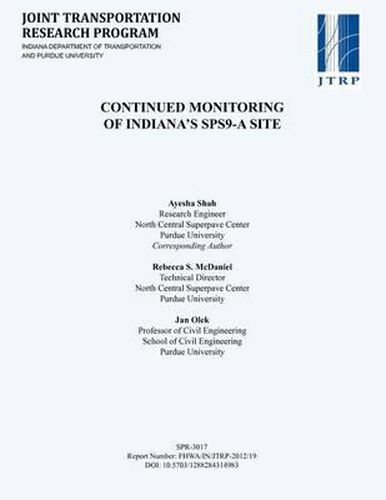Readings Newsletter
Become a Readings Member to make your shopping experience even easier.
Sign in or sign up for free!
You’re not far away from qualifying for FREE standard shipping within Australia
You’ve qualified for FREE standard shipping within Australia
The cart is loading…






This study was initiated to continue monitoring of the performance of five test sections placed in 1997 to compare the performance of Superpave asphalt mixtures with different binder grades and one test section designed using the Marshall mix design method. A previous study had evaluated the performance of these test sections for four years after construction. This study extended that evaluation period to 12 years. During that time period, cores were taken from each test section at 9.5 and 12 years in service. Cores were tested and analyzed to determine the volumetrics and low temperature cracking behavior of the mixtures. Additional cores were used to extract, recover and test the binder in the mixtures. Results showed that the air void content in the mixtures did continue to decrease up to about nine years then appears to have leveled off. Aging (stiffening) of the unmodified binders was observed through Dynamic Shear Rheometer testing of the recovered binders but not by the penetration test. The modified binder did not exhibit the same level of aging as the unmodified binders. Aging also affected the recovered low temperature binder grade of four of the six binders, but the other two seemed relatively insensitive to aging at low temperatures. Testing of field cores showed that all of the mixtures would be expected to show thermal cracking at 9.5 years and beyond; this was confirmed by field distress surveys. The mix with polymer modified binder showed the greatest amount of cracking, which began at an early age in the field; this was not expected and did not correlate well with the lab testing results for unknown reasons. The mix with 15% RAP was slightly stiffer than a companion control mix without RAP, but the difference in predicted cracking temperature was only 1 - 2 C for the surface mixes. Based on these results, INDOT can continue to use Superpave mixes with confidence, especially when considering the fact that Superpave has continued to evolve and be refined since this project was constructed. The mixture with RAP has performed about as well as the virgin mixtures under heavy interstate traffic.
$9.00 standard shipping within Australia
FREE standard shipping within Australia for orders over $100.00
Express & International shipping calculated at checkout
This study was initiated to continue monitoring of the performance of five test sections placed in 1997 to compare the performance of Superpave asphalt mixtures with different binder grades and one test section designed using the Marshall mix design method. A previous study had evaluated the performance of these test sections for four years after construction. This study extended that evaluation period to 12 years. During that time period, cores were taken from each test section at 9.5 and 12 years in service. Cores were tested and analyzed to determine the volumetrics and low temperature cracking behavior of the mixtures. Additional cores were used to extract, recover and test the binder in the mixtures. Results showed that the air void content in the mixtures did continue to decrease up to about nine years then appears to have leveled off. Aging (stiffening) of the unmodified binders was observed through Dynamic Shear Rheometer testing of the recovered binders but not by the penetration test. The modified binder did not exhibit the same level of aging as the unmodified binders. Aging also affected the recovered low temperature binder grade of four of the six binders, but the other two seemed relatively insensitive to aging at low temperatures. Testing of field cores showed that all of the mixtures would be expected to show thermal cracking at 9.5 years and beyond; this was confirmed by field distress surveys. The mix with polymer modified binder showed the greatest amount of cracking, which began at an early age in the field; this was not expected and did not correlate well with the lab testing results for unknown reasons. The mix with 15% RAP was slightly stiffer than a companion control mix without RAP, but the difference in predicted cracking temperature was only 1 - 2 C for the surface mixes. Based on these results, INDOT can continue to use Superpave mixes with confidence, especially when considering the fact that Superpave has continued to evolve and be refined since this project was constructed. The mixture with RAP has performed about as well as the virgin mixtures under heavy interstate traffic.